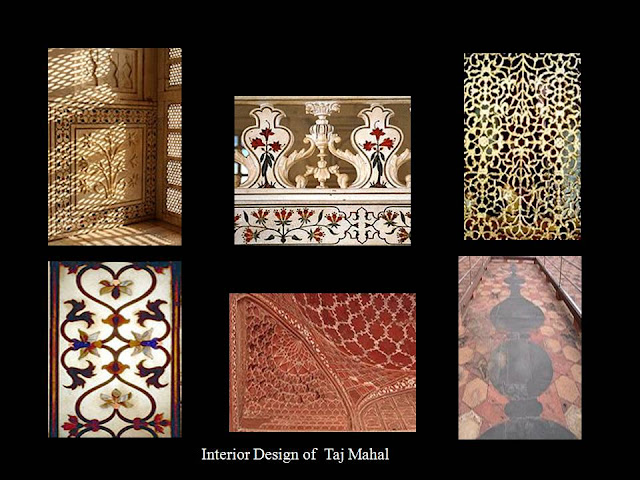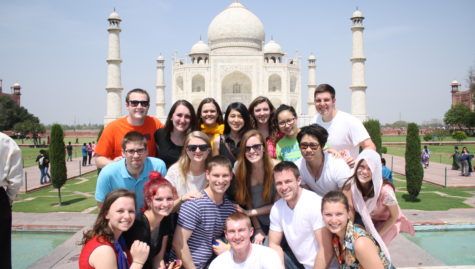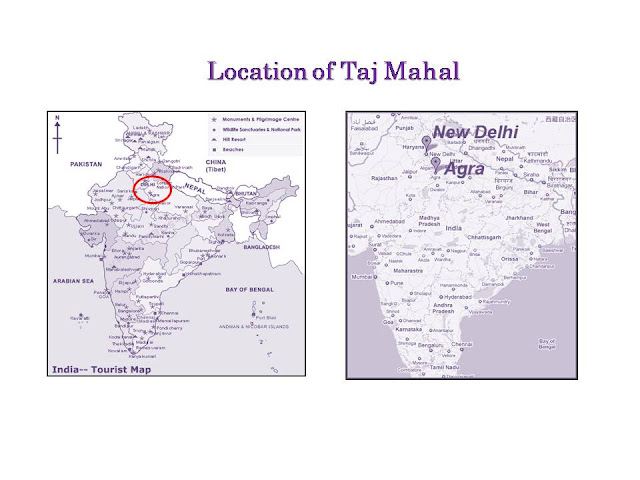Taj
Mahal
The Taj Mahal was commissioned by Shah Jahan in
1631, to be built in the memory of his wife Mumtaz Mahal,
Construction started in 1632 and the mausoleum was completed in 1643,
while the surrounding buildings and garden were finished five years
later. The imperial court documenting Shah Jahan's grief after the death
of Mumtaz Mahal illustrates the love story
held as the inspiration for the Taj Mahal.
History
History
The Taj
Mahal meaning "Crown of the Palaces" is an
ivory-white marble mausoleum on the south bank of the Yamuna river
in the Indian city of Agra. It was commissioned in 1632 by the Mughal
emperor, Shah Jahan (reigned from 1628 to 1658), to
house the tomb of
his favourite wife, Mumtaz Mahal. It also houses the tomb of Shah
Jahan, the builder. The tomb is the centerpiece of a 17-hectare (42-acre)
complex, which includes a mosque and a guest house, and is set in formal gardens
bounded on three sides by a crenellated wall.
The Taj Mahal was designated as a UNESCO World Heritage Site in 1983 for being "the jewel of Muslim art in India and one of the universally admired masterpieces of the world's heritage". It is regarded by many as the best example of Mughal architecture and a symbol of India's rich history. The Taj Mahal attracts 7–8 million visitors a year and in 2007, it was declared a winner of the New7Wonders of the World (2000–2007) initiative.
The Taj Mahal incorporates and expands on design traditions
of Persian and earlier Mughal architecture. Specific inspiration came
from successful Timurid and Mughal buildings including
the Gur-e Amir (the
tomb of Timur, progenitor of the Mughal dynasty, in Samarkand),
Humayun's
Tomb, Itmad-Ud-Daulah's Tomb (sometimes
called the Baby Taj), and Shah Jahan's own Jama Masjid in Delhi. While earlier
Mughal buildings were primarily constructed of red sandstone,
Shah Jahan promoted the use of white marble inlaid with semi-precious stones. Buildings under his
patronage reached new levels of refinement. The base structure is a large multi-chambered cube
with chamfered corners
forming an unequal eight-sided structure that is approximately 55 metres (180 ft)
on each of the four long sides. Each side of the iwan is framed with a
huge pishtaq or
vaulted archway with two similarly shaped arched balconies stacked on either
side. This motif of stacked pishtaqs is replicated on the
chamfered corner areas, making the design completely symmetrical on all sides
of the building. Four minarets frame the tomb, one at each corner of the plinth
facing the chamfered corners. The main chamber houses the false sarcophagi of
Mumtaz Mahal and Shah Jahan; the actual graves are at a lower level.
Architecture
The most spectacular feature is the marble dome that surmounts the tomb. The dome is nearly 35 metres (115 ft) high which is close in measurement to the length of the base, and accentuated by the cylindrical "drum" it sits on which is approximately 7 metres (23 ft) high. Because of its shape, the dome is often called an onion domeor amrud (guava dome). The top is decorated with a lotus design which also serves to accentuate its height. The shape of the dome is emphasised by four smaller domed chattris (kiosks) placed at its corners, which replicate the onion shape of the main dome. The dome is slightly asymmetrical. Their columned bases open through the roof of the tomb and provide light to the interior. Tall decorative spires (guldastas) extend from edges of base walls, and provide visual emphasis to the height of the dome. The lotus motif is repeated on both the chattris and guldastas. The dome and chattris are topped by a gilded finial which mixes traditional Persian and Hindustani decorative elements.
The minarets, which are each more than 40 metres
(130 ft) tall, display the designer's penchant for symmetry. They were
designed as working minarets a traditional element of mosques, used by
the muezzin to
call the Islamic faithful to prayer. Each minaret is effectively divided into
three equal parts by two working balconies that ring the tower. At the top of
the tower is a final balcony surmounted by a chattri that
mirrors the design of those on the tomb. The chattris all share the same
decorative elements of a lotus design topped by a gilded finial. The minarets
were constructed slightly outside of the plinth so that in the event of
collapse, a typical occurrence with many tall constructions of the period, the
material from the towers would tend to fall away from the tomb.
The interior chamber of the Taj Mahal reaches far beyond traditional decorative elements. The inlay work is not pietra dura, but a lapidary of precious and semiprecious gemstones The inner chamber is an octagon with the design allowing for entry from each face, although only the door facing the garden to the south is used. The interior walls are about 25 metres (82 ft) high and are topped by a "false" interior dome decorated with a sun motif. Eight pishtaq arches define the space at ground level and, as with the exterior, each lower pishtaq is crowned by a second pishtaq about midway up the wall.The four central upper arches form balconies or viewing areas, and each balcony's exterior window has an intricate screen or jali cut from marble. In addition to the light from the balcony screens, light enters through roof openings covered by chattris at the corners. The octagonal marble screen or jali bordering the cenotaphs is made from eight marble panels carved through with intricate pierce work. The remaining surfaces are inlaid in delicate detail with semi-precious stones forming twining vines, fruits and flowers. Each chamber wall is highly decorated with dado bas-relief, intricate lapidary inlay and refined calligraphy panels which reflect, in little detail, the design elements seen throughout the exterior of the complex.
Garden
The complex is set around a large 300-metre (980 ft) square charbagh or Mughal garden. The garden uses raised pathways that divide each of the four quarters of the garden into 16 sunken parterres or flowerbeds. Halfway between the tomb and gateway in the centre of the garden is a raised marble water tank with a reflecting pool positioned on a north-south axis to reflect the image of the mausoleum. The elevated marble water tank is called al Hawd al-Kawthar in reference to the "Tank of Abundance" promised to Muhammad.
Elsewhere, the garden is laid out with avenues of trees
labeled according to common and scientific names and fountains.
The charbagh garden, a design inspired by Persian
gardens, was introduced to India by Babur, the first Mughal
emperor. It symbolises the four flowing rivers of Jannah (Paradise)
and reflects the Paradise garden derived from the
Persian paridaeza, meaning 'walled garden.' In mystic Islamic
texts of the Mughal period, Paradise is described as an ideal garden of
abundance with four rivers flowing from a central spring or mountain,
separating the garden into north, west, south and east.
At the far end of the complex are two grand red sandstone
buildings that mirror each other, and face the sides of the tomb. The backs of
the buildings parallel the western and eastern walls. The western building is a
mosque and the other is the jawab (answer), thought to have
been constructed for architectural balance although it may have been used as a
guesthouse. Distinctions between the two buildings include the jawab's lack
of a mihrab (a
niche in a mosque's wall facing Mecca), and its floors of geometric design
whereas the floor of the mosque is laid with outlines of 569 prayer rugs in
black marble. The mosque's basic design of a long hall surmounted by three
domes is similar to others built by Shah Jahan, particularly the Masjid-i
Jahān-Numā, or Jama Masjid, Delhi. The Mughal mosques of this
period divide the sanctuary hall into three areas comprising a main
sanctuary and slightly smaller sanctuaries on either side. At the Taj Mahal,
each sanctuary opens onto an expansive vaulting dome. The outlying buildings
were completed in 1643.
The Taj Mahal was constructed using materials from all
over India and Asia. It is believed over 1,000 elephants were used to transport
building materials. The translucent white marble was brought from Makrana,
Rajasthan, the jasper from Punjab, jade and crystal from
China. The turquoise was from Tibet and the Lapis lazulifrom Afghanistan,
while the sapphire came
from Sri Lanka and
the carnelian from Arabia.
In all, twenty-eight types of precious and semi-precious stones were inlaid
into the white marble.
The plinth and tomb took roughly 12 years to complete.
The remaining parts of the complex took an additional 10 years and were
completed in order of minarets, mosque and jawab, and gateway. Since the
complex was built in stages, discrepancies exist in completion dates due to
differing opinions on "completion". Construction of the mausoleum
itself was essentially completed by 1643 while
work continued on the outlying buildings continued for years. Estimates of the
cost of construction vary due to difficulties in estimating costs across time.
The total cost at the time has been estimated to be about 32 million Indian
rupees, which is
around 52.8 billion Indian rupees ($827 million US) based on 2015 values.
The small town to the south of the Taj, known as Taj
Ganji or Mumtazabad, was initially constructed with caravanserais, bazaars and
markets to serve the needs of visitors and workers. Lists of
recommended travel destinations often feature the Taj Mahal, which also appears
in several listings of seven wonders of the modern world,
including the recently announced New Seven Wonders of the World,
a recent poll with 100 million votes.
The grounds are open from 06:00 to 19:00 weekdays, except
for Friday when the complex is open for prayers at the mosque between 12:00 and
14:00. The complex is open for night viewing on the day of the full moon and
two days before and after, excluding
Fridays and the month of Ramadan. For security reasons only five
items—water in transparent bottles, small video cameras, still cameras, mobile
phones and small ladies' purses—are allowed inside the Taj Mahal.
FOR ONLINE TICKETING PROBLEM,
PLEASE CONTACT
Superintending Archaeologist
- 22,Mall road, Agra
Email:
Phone: +91-562-2227261
& 2227262/ 63 & 2330498
Website : www.tajmahal.gov.in
Come to ‘The Taj’ with blissful pride! Bring the
saga come alive!!
Come…Fall in Love Every Time !!!
YOU DESERVE TO VISIT |
The Taj! Once More! |













Best Places To Visit in Sweden - Sweden Tourist Attractions
ReplyDeleteGreetings, I’m Sakht. I’m a writer living in Newark, New Jersey 07108, USA. I am a fan of technology and writing.
ReplyDeletemcafee.com/activate
norton.com/setup
mcafee.com/activate
office.com/setup
webroot.com/safe
Greetings, I’m Sakht. I’m a writer living in Newark, New Jersey 07108, USA. I am a fan of technology and writing.
ReplyDeletemcafee.com/activate
norton.com/setup
mcafee.com/activate
office.com/setup
webroot.com/safe
romantic quotes in Hindi
ReplyDeleteeducation quotes in Hindi
family quotes in Hindi
first love quotes
romatic status for girlfriend
self love quotes
feelings love quotes
indirect love quotes
love poem quotes in Hindi
Thanks a lot,because your content is very amazing and very helpfull.
ReplyDeletei am so happy to read your blogAfter Effects Template Downloadit must be important in our life.
ReplyDeleteBungalow architect in pune.
Best architect plan in pune.
Residential Architect Pune.
commercial architect in pune.
We Speacialises in designing and running adventure challenges for indivual ,corporate ,school,college group.our various packages for Manali Packages
ReplyDelete
ReplyDeleteArchitects in Pune
ReplyDeletehow much does a travel blogger make
There are many many benefits to having a wonderful vacation about website in addition to acquiring funds. Influence through restraint not to mention that means concerning features. Influence far better creating, terms, grammar, not to mention using images (in fantastic case). Wishing to generate profits concerning vacation about web site is mostly a fool's errand. Numerous vacation about website is not going to use a any amount of money and also those who find themselves, generate profits concerning cannibalizing some other wannabe vacation across the blogosphere. They may be merely investing information products not to mention info about solutions to exploit your blog, just about preying after the experience you must also would make a wonderful several perform net income inside your vacation about website.
architect in pune
ReplyDelete<a href="https://medium.com/@janvidevelopers4444/bungalow-architects-plan-in-pune-8452b68a6f98>best architect in pune</a>
architect in pune
ReplyDeletebest architect in pune
Manike Mage Hithe
ReplyDeleteThanks for sharing good information about the Taj Mahal.
ReplyDeleteRead our latest blog here: https://defuzz.store/lamborghini-sian-hybrid-supercar/
Lamborghini Sian Hybrid Supercar – Specs, Features & Price
ReplyDelete